Understanding Social Behaviour: Self-Efficacy in Sports
VerifiedAdded on 2020/05/08
|9
|2557
|133
Essay
AI Summary
This essay delves into the concept of self-efficacy, particularly its significance in the realm of adolescent sports. It explores how self-efficacy, defined as an individual's belief in their ability to succeed, influences performance and the ability to cope with losses. The essay discusses theoretical underpinnings, including Social Cognitive Theory, and examines factors such as mastery experience, vicarious learning, verbal persuasion, and emotional states that impact self-efficacy. The research focuses on 11-17-year-old soccer and netball players, analyzing the role of coaches and emotional stability in influencing self-efficacy levels. The essay highlights the importance of positive thinking, effective coaching, and participation in maintaining and enhancing self-efficacy. It concludes that self-efficacy is crucial for motivating individuals and emphasizes the need for emotional stability and a positive attitude to achieve success in sports. The essay also suggests future research directions focused on improving factors that contribute to individual self-efficacy.
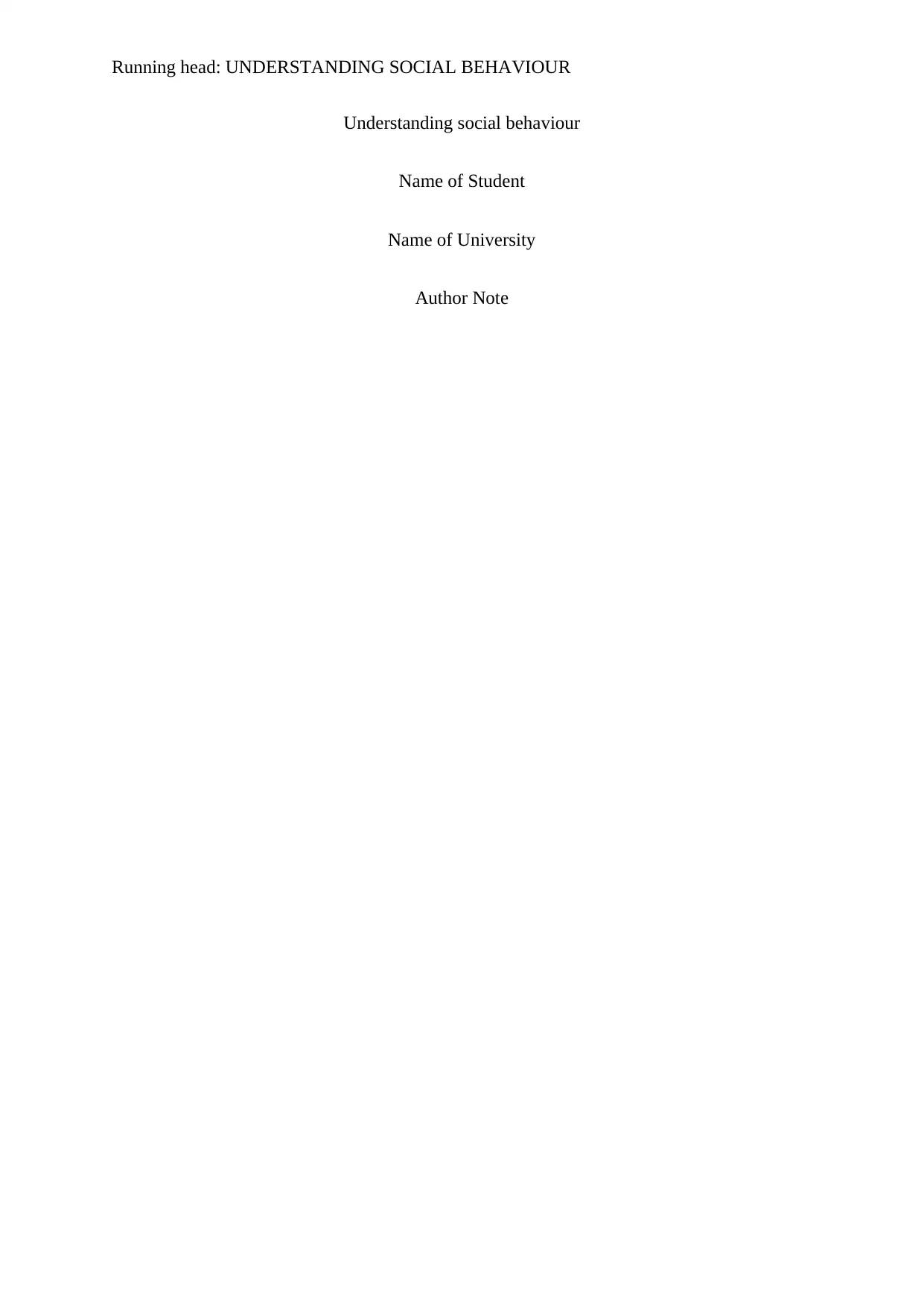
Running head: UNDERSTANDING SOCIAL BEHAVIOUR
Understanding social behaviour
Name of Student
Name of University
Author Note
Understanding social behaviour
Name of Student
Name of University
Author Note
Paraphrase This Document
Need a fresh take? Get an instant paraphrase of this document with our AI Paraphraser
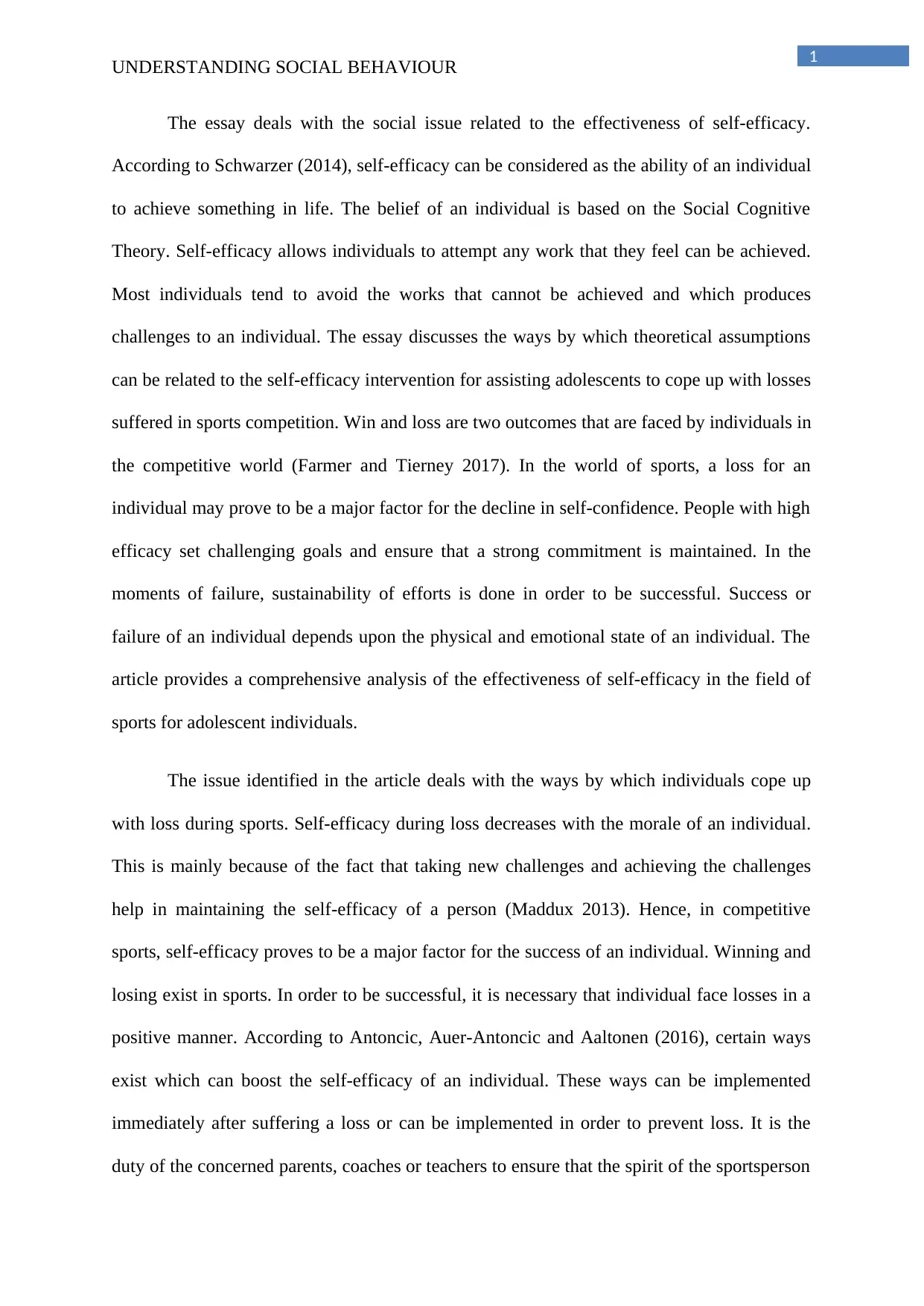
1
UNDERSTANDING SOCIAL BEHAVIOUR
The essay deals with the social issue related to the effectiveness of self-efficacy.
According to Schwarzer (2014), self-efficacy can be considered as the ability of an individual
to achieve something in life. The belief of an individual is based on the Social Cognitive
Theory. Self-efficacy allows individuals to attempt any work that they feel can be achieved.
Most individuals tend to avoid the works that cannot be achieved and which produces
challenges to an individual. The essay discusses the ways by which theoretical assumptions
can be related to the self-efficacy intervention for assisting adolescents to cope up with losses
suffered in sports competition. Win and loss are two outcomes that are faced by individuals in
the competitive world (Farmer and Tierney 2017). In the world of sports, a loss for an
individual may prove to be a major factor for the decline in self-confidence. People with high
efficacy set challenging goals and ensure that a strong commitment is maintained. In the
moments of failure, sustainability of efforts is done in order to be successful. Success or
failure of an individual depends upon the physical and emotional state of an individual. The
article provides a comprehensive analysis of the effectiveness of self-efficacy in the field of
sports for adolescent individuals.
The issue identified in the article deals with the ways by which individuals cope up
with loss during sports. Self-efficacy during loss decreases with the morale of an individual.
This is mainly because of the fact that taking new challenges and achieving the challenges
help in maintaining the self-efficacy of a person (Maddux 2013). Hence, in competitive
sports, self-efficacy proves to be a major factor for the success of an individual. Winning and
losing exist in sports. In order to be successful, it is necessary that individual face losses in a
positive manner. According to Antoncic, Auer-Antoncic and Aaltonen (2016), certain ways
exist which can boost the self-efficacy of an individual. These ways can be implemented
immediately after suffering a loss or can be implemented in order to prevent loss. It is the
duty of the concerned parents, coaches or teachers to ensure that the spirit of the sportsperson
UNDERSTANDING SOCIAL BEHAVIOUR
The essay deals with the social issue related to the effectiveness of self-efficacy.
According to Schwarzer (2014), self-efficacy can be considered as the ability of an individual
to achieve something in life. The belief of an individual is based on the Social Cognitive
Theory. Self-efficacy allows individuals to attempt any work that they feel can be achieved.
Most individuals tend to avoid the works that cannot be achieved and which produces
challenges to an individual. The essay discusses the ways by which theoretical assumptions
can be related to the self-efficacy intervention for assisting adolescents to cope up with losses
suffered in sports competition. Win and loss are two outcomes that are faced by individuals in
the competitive world (Farmer and Tierney 2017). In the world of sports, a loss for an
individual may prove to be a major factor for the decline in self-confidence. People with high
efficacy set challenging goals and ensure that a strong commitment is maintained. In the
moments of failure, sustainability of efforts is done in order to be successful. Success or
failure of an individual depends upon the physical and emotional state of an individual. The
article provides a comprehensive analysis of the effectiveness of self-efficacy in the field of
sports for adolescent individuals.
The issue identified in the article deals with the ways by which individuals cope up
with loss during sports. Self-efficacy during loss decreases with the morale of an individual.
This is mainly because of the fact that taking new challenges and achieving the challenges
help in maintaining the self-efficacy of a person (Maddux 2013). Hence, in competitive
sports, self-efficacy proves to be a major factor for the success of an individual. Winning and
losing exist in sports. In order to be successful, it is necessary that individual face losses in a
positive manner. According to Antoncic, Auer-Antoncic and Aaltonen (2016), certain ways
exist which can boost the self-efficacy of an individual. These ways can be implemented
immediately after suffering a loss or can be implemented in order to prevent loss. It is the
duty of the concerned parents, coaches or teachers to ensure that the spirit of the sportsperson
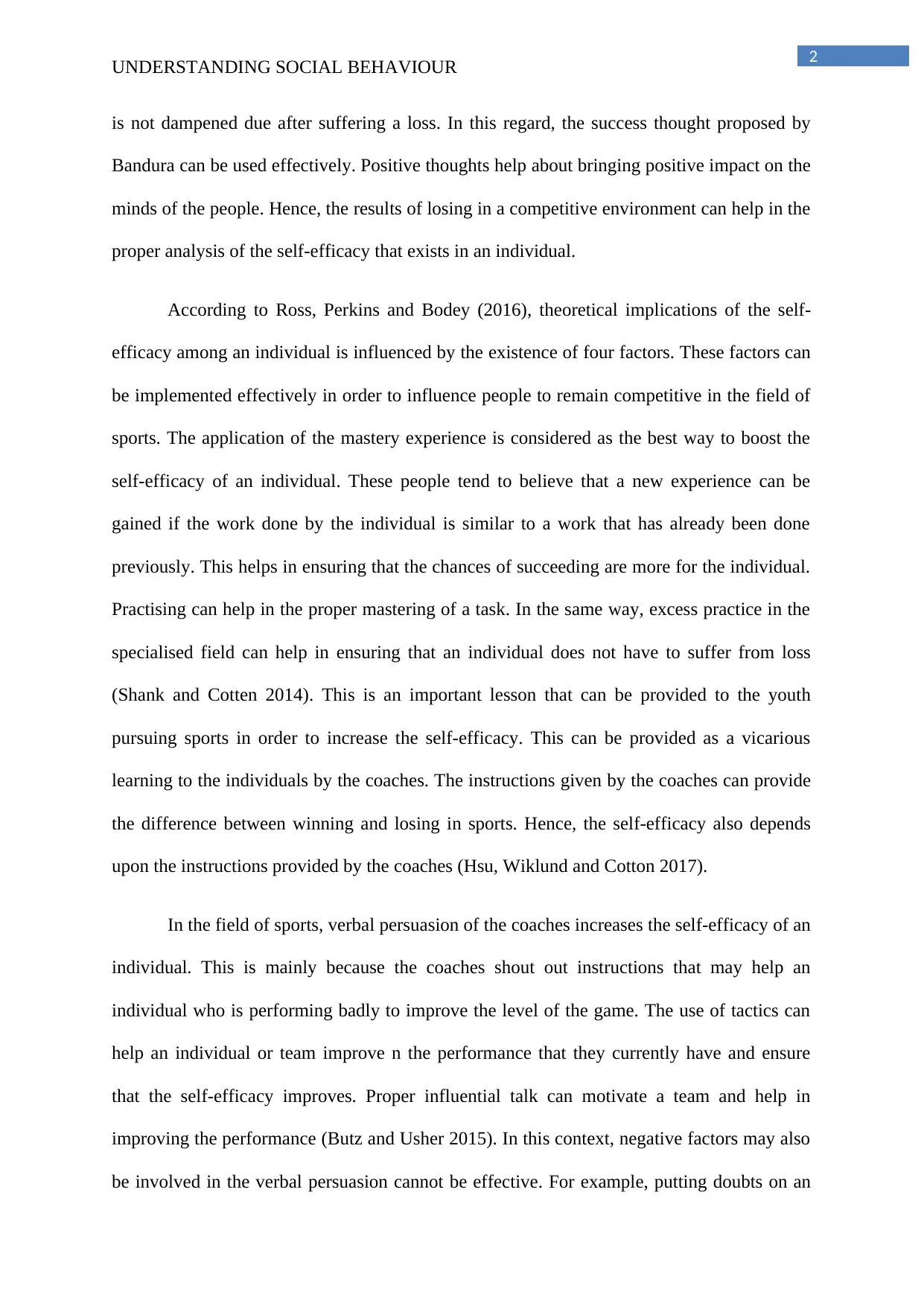
2
UNDERSTANDING SOCIAL BEHAVIOUR
is not dampened due after suffering a loss. In this regard, the success thought proposed by
Bandura can be used effectively. Positive thoughts help about bringing positive impact on the
minds of the people. Hence, the results of losing in a competitive environment can help in the
proper analysis of the self-efficacy that exists in an individual.
According to Ross, Perkins and Bodey (2016), theoretical implications of the self-
efficacy among an individual is influenced by the existence of four factors. These factors can
be implemented effectively in order to influence people to remain competitive in the field of
sports. The application of the mastery experience is considered as the best way to boost the
self-efficacy of an individual. These people tend to believe that a new experience can be
gained if the work done by the individual is similar to a work that has already been done
previously. This helps in ensuring that the chances of succeeding are more for the individual.
Practising can help in the proper mastering of a task. In the same way, excess practice in the
specialised field can help in ensuring that an individual does not have to suffer from loss
(Shank and Cotten 2014). This is an important lesson that can be provided to the youth
pursuing sports in order to increase the self-efficacy. This can be provided as a vicarious
learning to the individuals by the coaches. The instructions given by the coaches can provide
the difference between winning and losing in sports. Hence, the self-efficacy also depends
upon the instructions provided by the coaches (Hsu, Wiklund and Cotton 2017).
In the field of sports, verbal persuasion of the coaches increases the self-efficacy of an
individual. This is mainly because the coaches shout out instructions that may help an
individual who is performing badly to improve the level of the game. The use of tactics can
help an individual or team improve n the performance that they currently have and ensure
that the self-efficacy improves. Proper influential talk can motivate a team and help in
improving the performance (Butz and Usher 2015). In this context, negative factors may also
be involved in the verbal persuasion cannot be effective. For example, putting doubts on an
UNDERSTANDING SOCIAL BEHAVIOUR
is not dampened due after suffering a loss. In this regard, the success thought proposed by
Bandura can be used effectively. Positive thoughts help about bringing positive impact on the
minds of the people. Hence, the results of losing in a competitive environment can help in the
proper analysis of the self-efficacy that exists in an individual.
According to Ross, Perkins and Bodey (2016), theoretical implications of the self-
efficacy among an individual is influenced by the existence of four factors. These factors can
be implemented effectively in order to influence people to remain competitive in the field of
sports. The application of the mastery experience is considered as the best way to boost the
self-efficacy of an individual. These people tend to believe that a new experience can be
gained if the work done by the individual is similar to a work that has already been done
previously. This helps in ensuring that the chances of succeeding are more for the individual.
Practising can help in the proper mastering of a task. In the same way, excess practice in the
specialised field can help in ensuring that an individual does not have to suffer from loss
(Shank and Cotten 2014). This is an important lesson that can be provided to the youth
pursuing sports in order to increase the self-efficacy. This can be provided as a vicarious
learning to the individuals by the coaches. The instructions given by the coaches can provide
the difference between winning and losing in sports. Hence, the self-efficacy also depends
upon the instructions provided by the coaches (Hsu, Wiklund and Cotton 2017).
In the field of sports, verbal persuasion of the coaches increases the self-efficacy of an
individual. This is mainly because the coaches shout out instructions that may help an
individual who is performing badly to improve the level of the game. The use of tactics can
help an individual or team improve n the performance that they currently have and ensure
that the self-efficacy improves. Proper influential talk can motivate a team and help in
improving the performance (Butz and Usher 2015). In this context, negative factors may also
be involved in the verbal persuasion cannot be effective. For example, putting doubts on an
⊘ This is a preview!⊘
Do you want full access?
Subscribe today to unlock all pages.

Trusted by 1+ million students worldwide
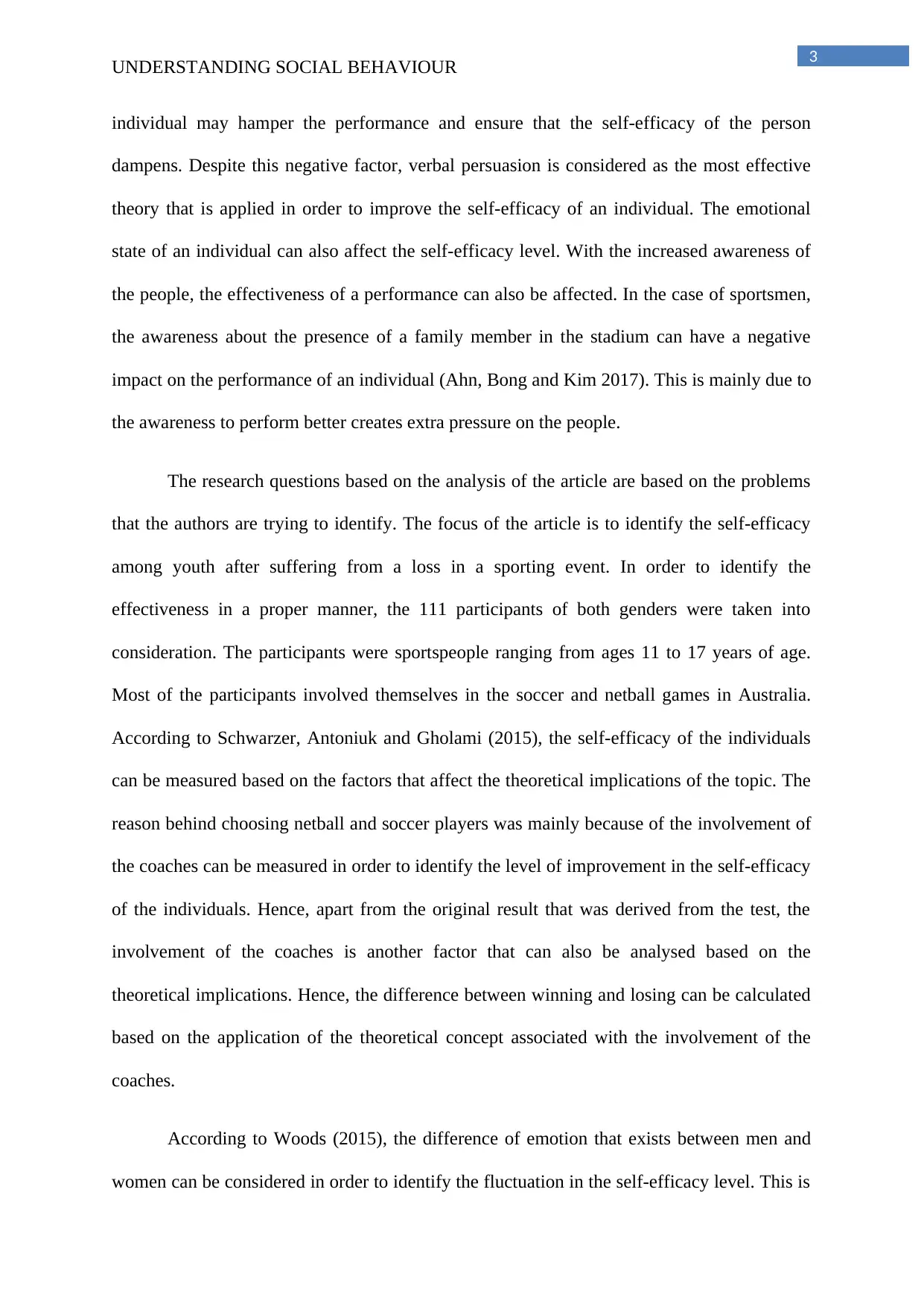
3
UNDERSTANDING SOCIAL BEHAVIOUR
individual may hamper the performance and ensure that the self-efficacy of the person
dampens. Despite this negative factor, verbal persuasion is considered as the most effective
theory that is applied in order to improve the self-efficacy of an individual. The emotional
state of an individual can also affect the self-efficacy level. With the increased awareness of
the people, the effectiveness of a performance can also be affected. In the case of sportsmen,
the awareness about the presence of a family member in the stadium can have a negative
impact on the performance of an individual (Ahn, Bong and Kim 2017). This is mainly due to
the awareness to perform better creates extra pressure on the people.
The research questions based on the analysis of the article are based on the problems
that the authors are trying to identify. The focus of the article is to identify the self-efficacy
among youth after suffering from a loss in a sporting event. In order to identify the
effectiveness in a proper manner, the 111 participants of both genders were taken into
consideration. The participants were sportspeople ranging from ages 11 to 17 years of age.
Most of the participants involved themselves in the soccer and netball games in Australia.
According to Schwarzer, Antoniuk and Gholami (2015), the self-efficacy of the individuals
can be measured based on the factors that affect the theoretical implications of the topic. The
reason behind choosing netball and soccer players was mainly because of the involvement of
the coaches can be measured in order to identify the level of improvement in the self-efficacy
of the individuals. Hence, apart from the original result that was derived from the test, the
involvement of the coaches is another factor that can also be analysed based on the
theoretical implications. Hence, the difference between winning and losing can be calculated
based on the application of the theoretical concept associated with the involvement of the
coaches.
According to Woods (2015), the difference of emotion that exists between men and
women can be considered in order to identify the fluctuation in the self-efficacy level. This is
UNDERSTANDING SOCIAL BEHAVIOUR
individual may hamper the performance and ensure that the self-efficacy of the person
dampens. Despite this negative factor, verbal persuasion is considered as the most effective
theory that is applied in order to improve the self-efficacy of an individual. The emotional
state of an individual can also affect the self-efficacy level. With the increased awareness of
the people, the effectiveness of a performance can also be affected. In the case of sportsmen,
the awareness about the presence of a family member in the stadium can have a negative
impact on the performance of an individual (Ahn, Bong and Kim 2017). This is mainly due to
the awareness to perform better creates extra pressure on the people.
The research questions based on the analysis of the article are based on the problems
that the authors are trying to identify. The focus of the article is to identify the self-efficacy
among youth after suffering from a loss in a sporting event. In order to identify the
effectiveness in a proper manner, the 111 participants of both genders were taken into
consideration. The participants were sportspeople ranging from ages 11 to 17 years of age.
Most of the participants involved themselves in the soccer and netball games in Australia.
According to Schwarzer, Antoniuk and Gholami (2015), the self-efficacy of the individuals
can be measured based on the factors that affect the theoretical implications of the topic. The
reason behind choosing netball and soccer players was mainly because of the involvement of
the coaches can be measured in order to identify the level of improvement in the self-efficacy
of the individuals. Hence, apart from the original result that was derived from the test, the
involvement of the coaches is another factor that can also be analysed based on the
theoretical implications. Hence, the difference between winning and losing can be calculated
based on the application of the theoretical concept associated with the involvement of the
coaches.
According to Woods (2015), the difference of emotion that exists between men and
women can be considered in order to identify the fluctuation in the self-efficacy level. This is
Paraphrase This Document
Need a fresh take? Get an instant paraphrase of this document with our AI Paraphraser
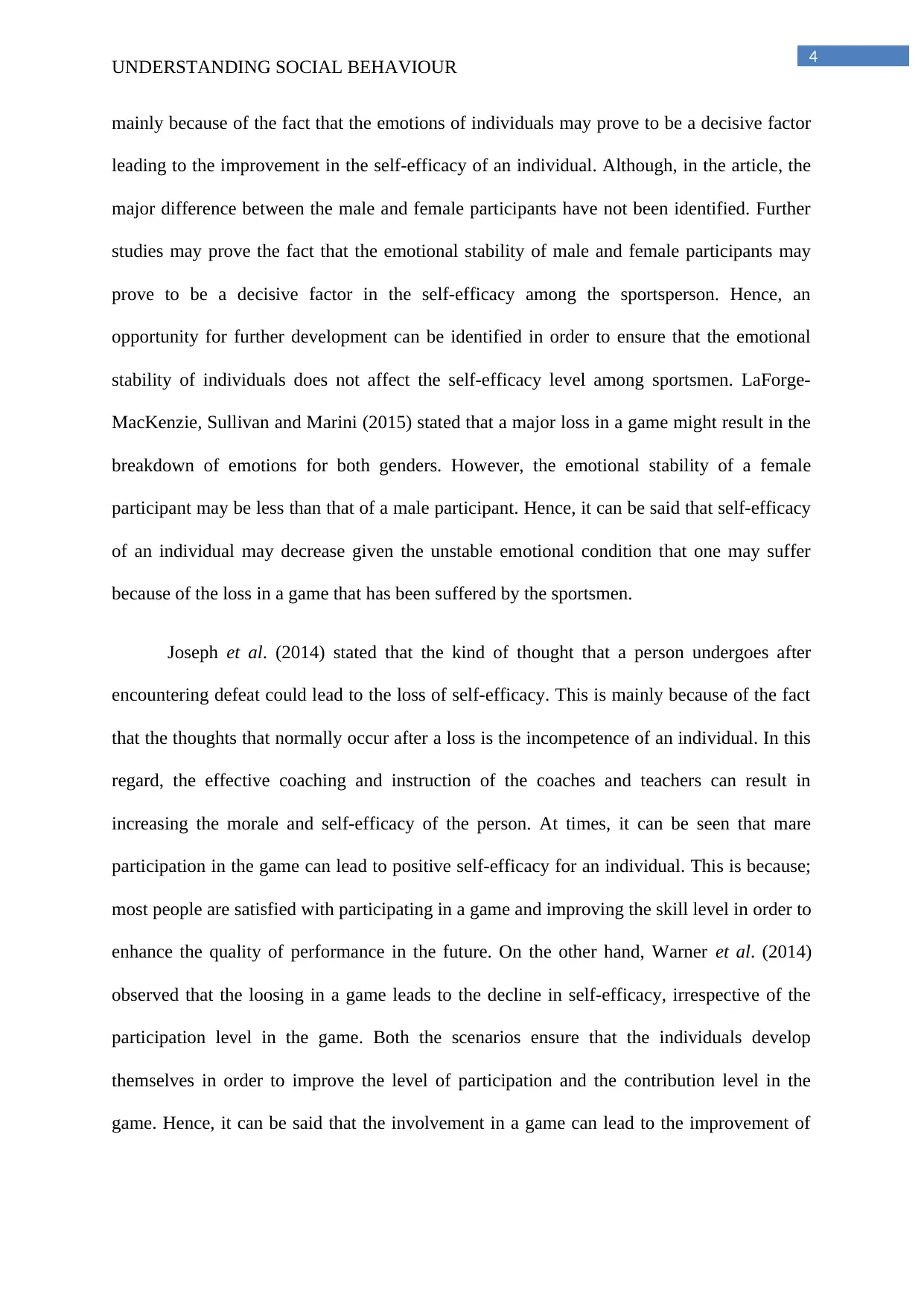
4
UNDERSTANDING SOCIAL BEHAVIOUR
mainly because of the fact that the emotions of individuals may prove to be a decisive factor
leading to the improvement in the self-efficacy of an individual. Although, in the article, the
major difference between the male and female participants have not been identified. Further
studies may prove the fact that the emotional stability of male and female participants may
prove to be a decisive factor in the self-efficacy among the sportsperson. Hence, an
opportunity for further development can be identified in order to ensure that the emotional
stability of individuals does not affect the self-efficacy level among sportsmen. LaForge-
MacKenzie, Sullivan and Marini (2015) stated that a major loss in a game might result in the
breakdown of emotions for both genders. However, the emotional stability of a female
participant may be less than that of a male participant. Hence, it can be said that self-efficacy
of an individual may decrease given the unstable emotional condition that one may suffer
because of the loss in a game that has been suffered by the sportsmen.
Joseph et al. (2014) stated that the kind of thought that a person undergoes after
encountering defeat could lead to the loss of self-efficacy. This is mainly because of the fact
that the thoughts that normally occur after a loss is the incompetence of an individual. In this
regard, the effective coaching and instruction of the coaches and teachers can result in
increasing the morale and self-efficacy of the person. At times, it can be seen that mare
participation in the game can lead to positive self-efficacy for an individual. This is because;
most people are satisfied with participating in a game and improving the skill level in order to
enhance the quality of performance in the future. On the other hand, Warner et al. (2014)
observed that the loosing in a game leads to the decline in self-efficacy, irrespective of the
participation level in the game. Both the scenarios ensure that the individuals develop
themselves in order to improve the level of participation and the contribution level in the
game. Hence, it can be said that the involvement in a game can lead to the improvement of
UNDERSTANDING SOCIAL BEHAVIOUR
mainly because of the fact that the emotions of individuals may prove to be a decisive factor
leading to the improvement in the self-efficacy of an individual. Although, in the article, the
major difference between the male and female participants have not been identified. Further
studies may prove the fact that the emotional stability of male and female participants may
prove to be a decisive factor in the self-efficacy among the sportsperson. Hence, an
opportunity for further development can be identified in order to ensure that the emotional
stability of individuals does not affect the self-efficacy level among sportsmen. LaForge-
MacKenzie, Sullivan and Marini (2015) stated that a major loss in a game might result in the
breakdown of emotions for both genders. However, the emotional stability of a female
participant may be less than that of a male participant. Hence, it can be said that self-efficacy
of an individual may decrease given the unstable emotional condition that one may suffer
because of the loss in a game that has been suffered by the sportsmen.
Joseph et al. (2014) stated that the kind of thought that a person undergoes after
encountering defeat could lead to the loss of self-efficacy. This is mainly because of the fact
that the thoughts that normally occur after a loss is the incompetence of an individual. In this
regard, the effective coaching and instruction of the coaches and teachers can result in
increasing the morale and self-efficacy of the person. At times, it can be seen that mare
participation in the game can lead to positive self-efficacy for an individual. This is because;
most people are satisfied with participating in a game and improving the skill level in order to
enhance the quality of performance in the future. On the other hand, Warner et al. (2014)
observed that the loosing in a game leads to the decline in self-efficacy, irrespective of the
participation level in the game. Both the scenarios ensure that the individuals develop
themselves in order to improve the level of participation and the contribution level in the
game. Hence, it can be said that the involvement in a game can lead to the improvement of
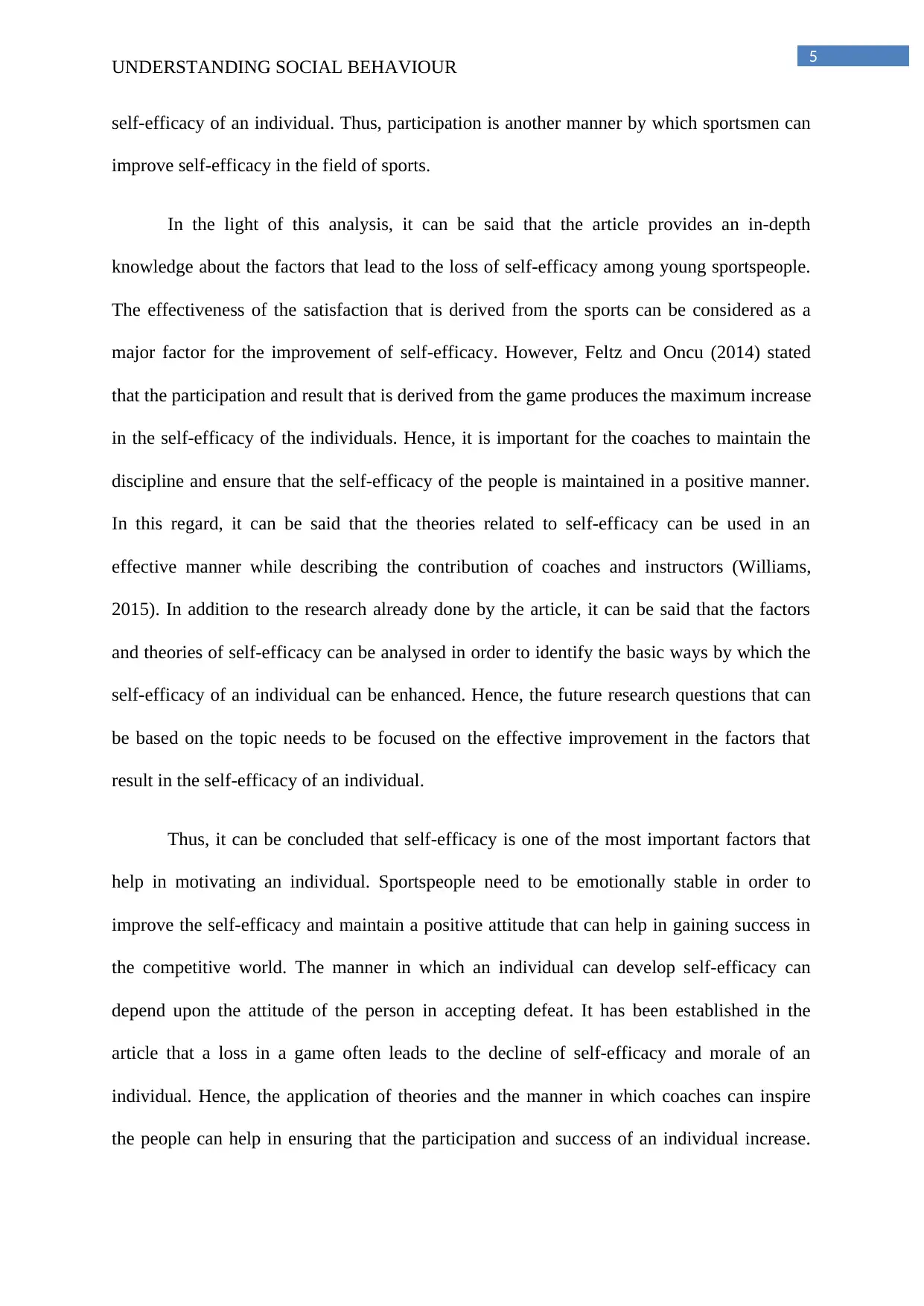
5
UNDERSTANDING SOCIAL BEHAVIOUR
self-efficacy of an individual. Thus, participation is another manner by which sportsmen can
improve self-efficacy in the field of sports.
In the light of this analysis, it can be said that the article provides an in-depth
knowledge about the factors that lead to the loss of self-efficacy among young sportspeople.
The effectiveness of the satisfaction that is derived from the sports can be considered as a
major factor for the improvement of self-efficacy. However, Feltz and Oncu (2014) stated
that the participation and result that is derived from the game produces the maximum increase
in the self-efficacy of the individuals. Hence, it is important for the coaches to maintain the
discipline and ensure that the self-efficacy of the people is maintained in a positive manner.
In this regard, it can be said that the theories related to self-efficacy can be used in an
effective manner while describing the contribution of coaches and instructors (Williams,
2015). In addition to the research already done by the article, it can be said that the factors
and theories of self-efficacy can be analysed in order to identify the basic ways by which the
self-efficacy of an individual can be enhanced. Hence, the future research questions that can
be based on the topic needs to be focused on the effective improvement in the factors that
result in the self-efficacy of an individual.
Thus, it can be concluded that self-efficacy is one of the most important factors that
help in motivating an individual. Sportspeople need to be emotionally stable in order to
improve the self-efficacy and maintain a positive attitude that can help in gaining success in
the competitive world. The manner in which an individual can develop self-efficacy can
depend upon the attitude of the person in accepting defeat. It has been established in the
article that a loss in a game often leads to the decline of self-efficacy and morale of an
individual. Hence, the application of theories and the manner in which coaches can inspire
the people can help in ensuring that the participation and success of an individual increase.
UNDERSTANDING SOCIAL BEHAVIOUR
self-efficacy of an individual. Thus, participation is another manner by which sportsmen can
improve self-efficacy in the field of sports.
In the light of this analysis, it can be said that the article provides an in-depth
knowledge about the factors that lead to the loss of self-efficacy among young sportspeople.
The effectiveness of the satisfaction that is derived from the sports can be considered as a
major factor for the improvement of self-efficacy. However, Feltz and Oncu (2014) stated
that the participation and result that is derived from the game produces the maximum increase
in the self-efficacy of the individuals. Hence, it is important for the coaches to maintain the
discipline and ensure that the self-efficacy of the people is maintained in a positive manner.
In this regard, it can be said that the theories related to self-efficacy can be used in an
effective manner while describing the contribution of coaches and instructors (Williams,
2015). In addition to the research already done by the article, it can be said that the factors
and theories of self-efficacy can be analysed in order to identify the basic ways by which the
self-efficacy of an individual can be enhanced. Hence, the future research questions that can
be based on the topic needs to be focused on the effective improvement in the factors that
result in the self-efficacy of an individual.
Thus, it can be concluded that self-efficacy is one of the most important factors that
help in motivating an individual. Sportspeople need to be emotionally stable in order to
improve the self-efficacy and maintain a positive attitude that can help in gaining success in
the competitive world. The manner in which an individual can develop self-efficacy can
depend upon the attitude of the person in accepting defeat. It has been established in the
article that a loss in a game often leads to the decline of self-efficacy and morale of an
individual. Hence, the application of theories and the manner in which coaches can inspire
the people can help in ensuring that the participation and success of an individual increase.
⊘ This is a preview!⊘
Do you want full access?
Subscribe today to unlock all pages.

Trusted by 1+ million students worldwide

6
UNDERSTANDING SOCIAL BEHAVIOUR
Thus, the contribution of every individual is necessary for maintaining the self-efficacy
among sportspeople.
UNDERSTANDING SOCIAL BEHAVIOUR
Thus, the contribution of every individual is necessary for maintaining the self-efficacy
among sportspeople.
Paraphrase This Document
Need a fresh take? Get an instant paraphrase of this document with our AI Paraphraser
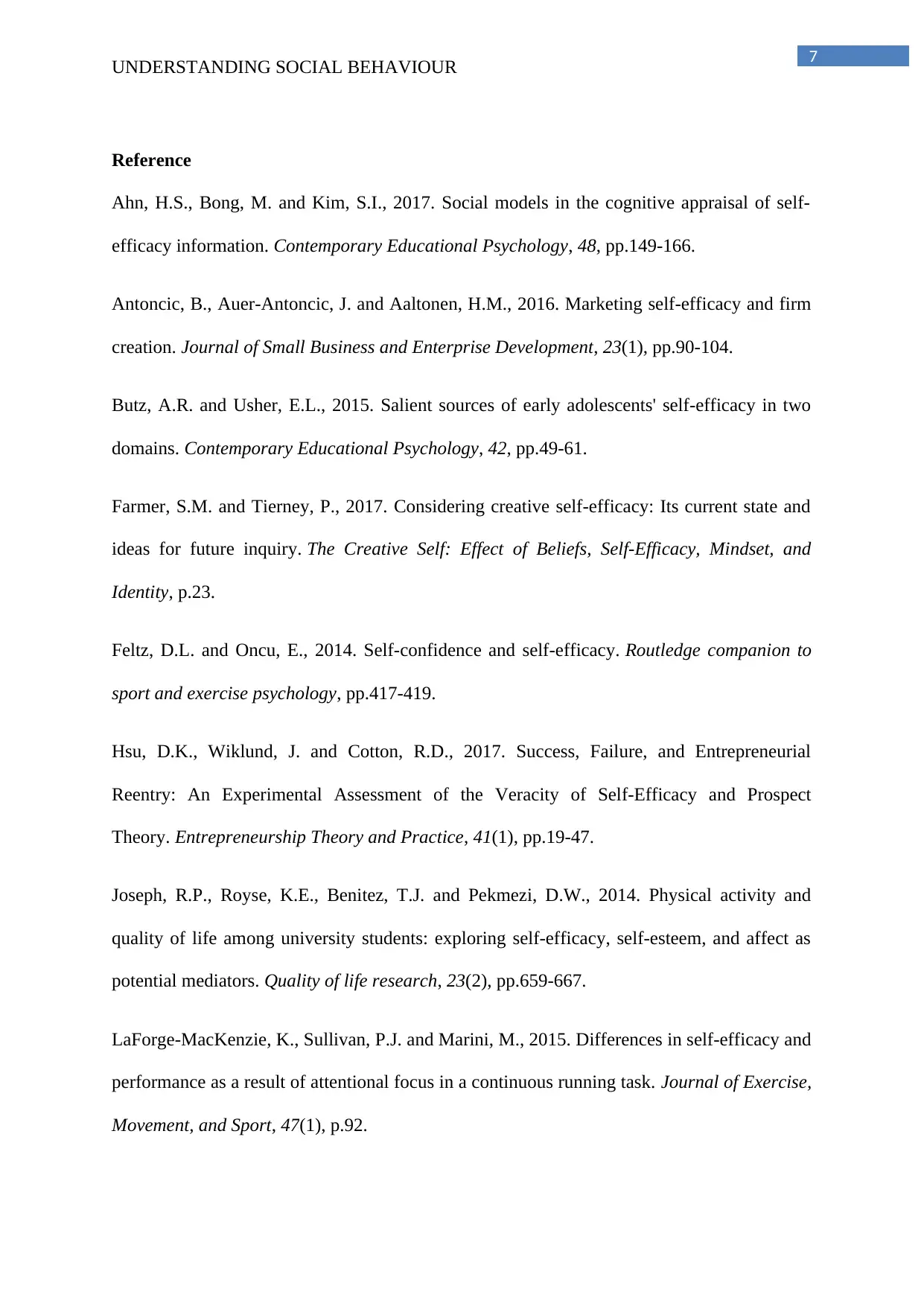
7
UNDERSTANDING SOCIAL BEHAVIOUR
Reference
Ahn, H.S., Bong, M. and Kim, S.I., 2017. Social models in the cognitive appraisal of self-
efficacy information. Contemporary Educational Psychology, 48, pp.149-166.
Antoncic, B., Auer-Antoncic, J. and Aaltonen, H.M., 2016. Marketing self-efficacy and firm
creation. Journal of Small Business and Enterprise Development, 23(1), pp.90-104.
Butz, A.R. and Usher, E.L., 2015. Salient sources of early adolescents' self-efficacy in two
domains. Contemporary Educational Psychology, 42, pp.49-61.
Farmer, S.M. and Tierney, P., 2017. Considering creative self-efficacy: Its current state and
ideas for future inquiry. The Creative Self: Effect of Beliefs, Self-Efficacy, Mindset, and
Identity, p.23.
Feltz, D.L. and Oncu, E., 2014. Self-confidence and self-efficacy. Routledge companion to
sport and exercise psychology, pp.417-419.
Hsu, D.K., Wiklund, J. and Cotton, R.D., 2017. Success, Failure, and Entrepreneurial
Reentry: An Experimental Assessment of the Veracity of Self‐Efficacy and Prospect
Theory. Entrepreneurship Theory and Practice, 41(1), pp.19-47.
Joseph, R.P., Royse, K.E., Benitez, T.J. and Pekmezi, D.W., 2014. Physical activity and
quality of life among university students: exploring self-efficacy, self-esteem, and affect as
potential mediators. Quality of life research, 23(2), pp.659-667.
LaForge-MacKenzie, K., Sullivan, P.J. and Marini, M., 2015. Differences in self-efficacy and
performance as a result of attentional focus in a continuous running task. Journal of Exercise,
Movement, and Sport, 47(1), p.92.
UNDERSTANDING SOCIAL BEHAVIOUR
Reference
Ahn, H.S., Bong, M. and Kim, S.I., 2017. Social models in the cognitive appraisal of self-
efficacy information. Contemporary Educational Psychology, 48, pp.149-166.
Antoncic, B., Auer-Antoncic, J. and Aaltonen, H.M., 2016. Marketing self-efficacy and firm
creation. Journal of Small Business and Enterprise Development, 23(1), pp.90-104.
Butz, A.R. and Usher, E.L., 2015. Salient sources of early adolescents' self-efficacy in two
domains. Contemporary Educational Psychology, 42, pp.49-61.
Farmer, S.M. and Tierney, P., 2017. Considering creative self-efficacy: Its current state and
ideas for future inquiry. The Creative Self: Effect of Beliefs, Self-Efficacy, Mindset, and
Identity, p.23.
Feltz, D.L. and Oncu, E., 2014. Self-confidence and self-efficacy. Routledge companion to
sport and exercise psychology, pp.417-419.
Hsu, D.K., Wiklund, J. and Cotton, R.D., 2017. Success, Failure, and Entrepreneurial
Reentry: An Experimental Assessment of the Veracity of Self‐Efficacy and Prospect
Theory. Entrepreneurship Theory and Practice, 41(1), pp.19-47.
Joseph, R.P., Royse, K.E., Benitez, T.J. and Pekmezi, D.W., 2014. Physical activity and
quality of life among university students: exploring self-efficacy, self-esteem, and affect as
potential mediators. Quality of life research, 23(2), pp.659-667.
LaForge-MacKenzie, K., Sullivan, P.J. and Marini, M., 2015. Differences in self-efficacy and
performance as a result of attentional focus in a continuous running task. Journal of Exercise,
Movement, and Sport, 47(1), p.92.
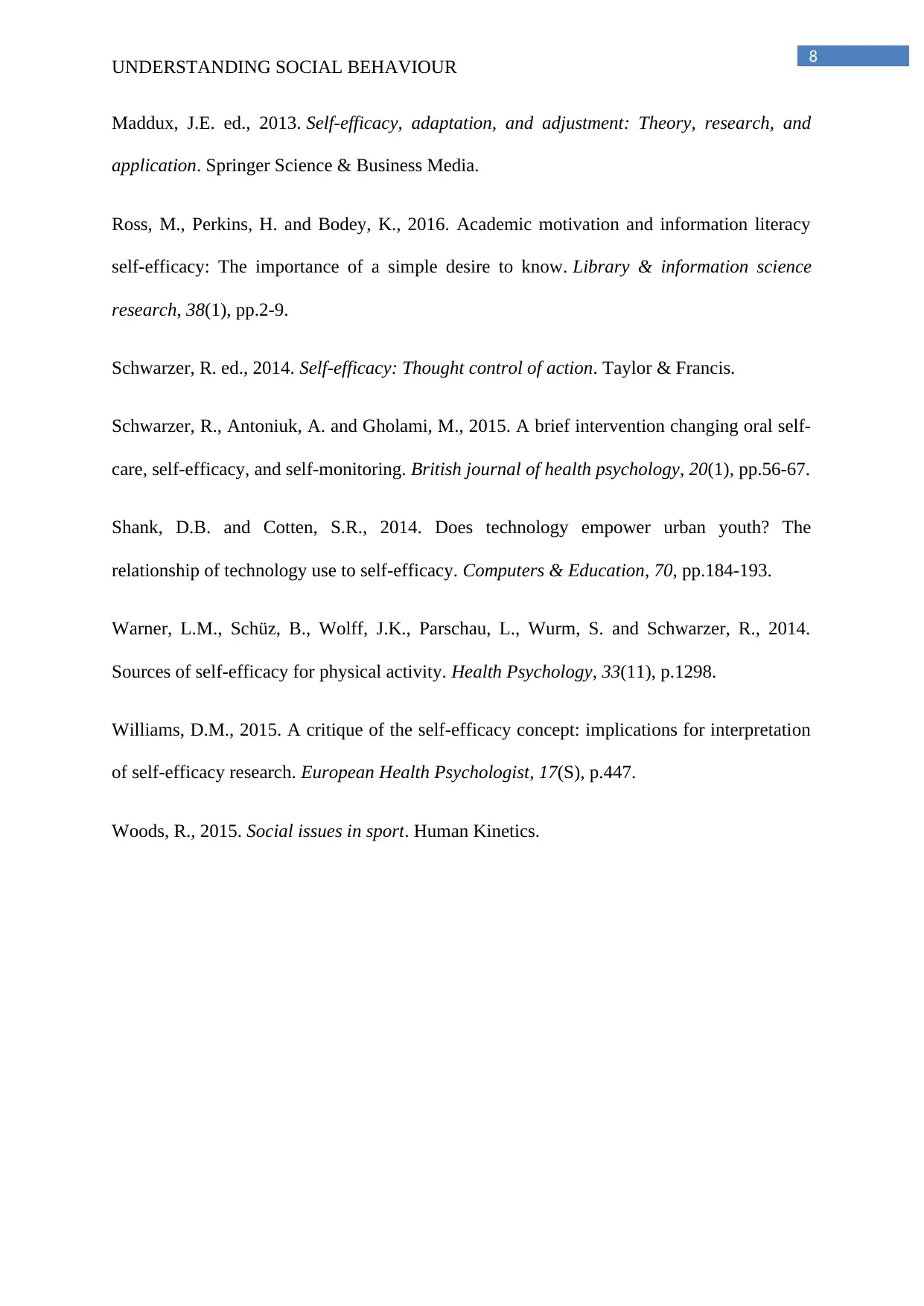
8
UNDERSTANDING SOCIAL BEHAVIOUR
Maddux, J.E. ed., 2013. Self-efficacy, adaptation, and adjustment: Theory, research, and
application. Springer Science & Business Media.
Ross, M., Perkins, H. and Bodey, K., 2016. Academic motivation and information literacy
self-efficacy: The importance of a simple desire to know. Library & information science
research, 38(1), pp.2-9.
Schwarzer, R. ed., 2014. Self-efficacy: Thought control of action. Taylor & Francis.
Schwarzer, R., Antoniuk, A. and Gholami, M., 2015. A brief intervention changing oral self‐
care, self‐efficacy, and self‐monitoring. British journal of health psychology, 20(1), pp.56-67.
Shank, D.B. and Cotten, S.R., 2014. Does technology empower urban youth? The
relationship of technology use to self-efficacy. Computers & Education, 70, pp.184-193.
Warner, L.M., Schüz, B., Wolff, J.K., Parschau, L., Wurm, S. and Schwarzer, R., 2014.
Sources of self-efficacy for physical activity. Health Psychology, 33(11), p.1298.
Williams, D.M., 2015. A critique of the self-efficacy concept: implications for interpretation
of self-efficacy research. European Health Psychologist, 17(S), p.447.
Woods, R., 2015. Social issues in sport. Human Kinetics.
UNDERSTANDING SOCIAL BEHAVIOUR
Maddux, J.E. ed., 2013. Self-efficacy, adaptation, and adjustment: Theory, research, and
application. Springer Science & Business Media.
Ross, M., Perkins, H. and Bodey, K., 2016. Academic motivation and information literacy
self-efficacy: The importance of a simple desire to know. Library & information science
research, 38(1), pp.2-9.
Schwarzer, R. ed., 2014. Self-efficacy: Thought control of action. Taylor & Francis.
Schwarzer, R., Antoniuk, A. and Gholami, M., 2015. A brief intervention changing oral self‐
care, self‐efficacy, and self‐monitoring. British journal of health psychology, 20(1), pp.56-67.
Shank, D.B. and Cotten, S.R., 2014. Does technology empower urban youth? The
relationship of technology use to self-efficacy. Computers & Education, 70, pp.184-193.
Warner, L.M., Schüz, B., Wolff, J.K., Parschau, L., Wurm, S. and Schwarzer, R., 2014.
Sources of self-efficacy for physical activity. Health Psychology, 33(11), p.1298.
Williams, D.M., 2015. A critique of the self-efficacy concept: implications for interpretation
of self-efficacy research. European Health Psychologist, 17(S), p.447.
Woods, R., 2015. Social issues in sport. Human Kinetics.
⊘ This is a preview!⊘
Do you want full access?
Subscribe today to unlock all pages.

Trusted by 1+ million students worldwide
1 out of 9
Related Documents
Your All-in-One AI-Powered Toolkit for Academic Success.
+13062052269
info@desklib.com
Available 24*7 on WhatsApp / Email
![[object Object]](/_next/static/media/star-bottom.7253800d.svg)
Unlock your academic potential
Copyright © 2020–2025 A2Z Services. All Rights Reserved. Developed and managed by ZUCOL.





